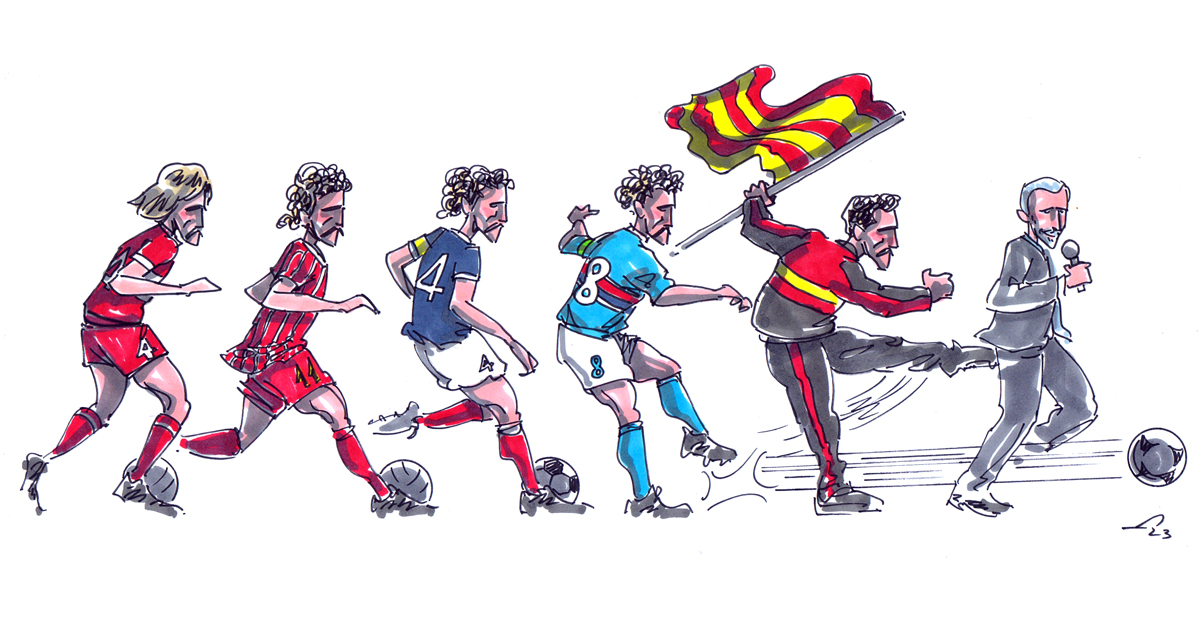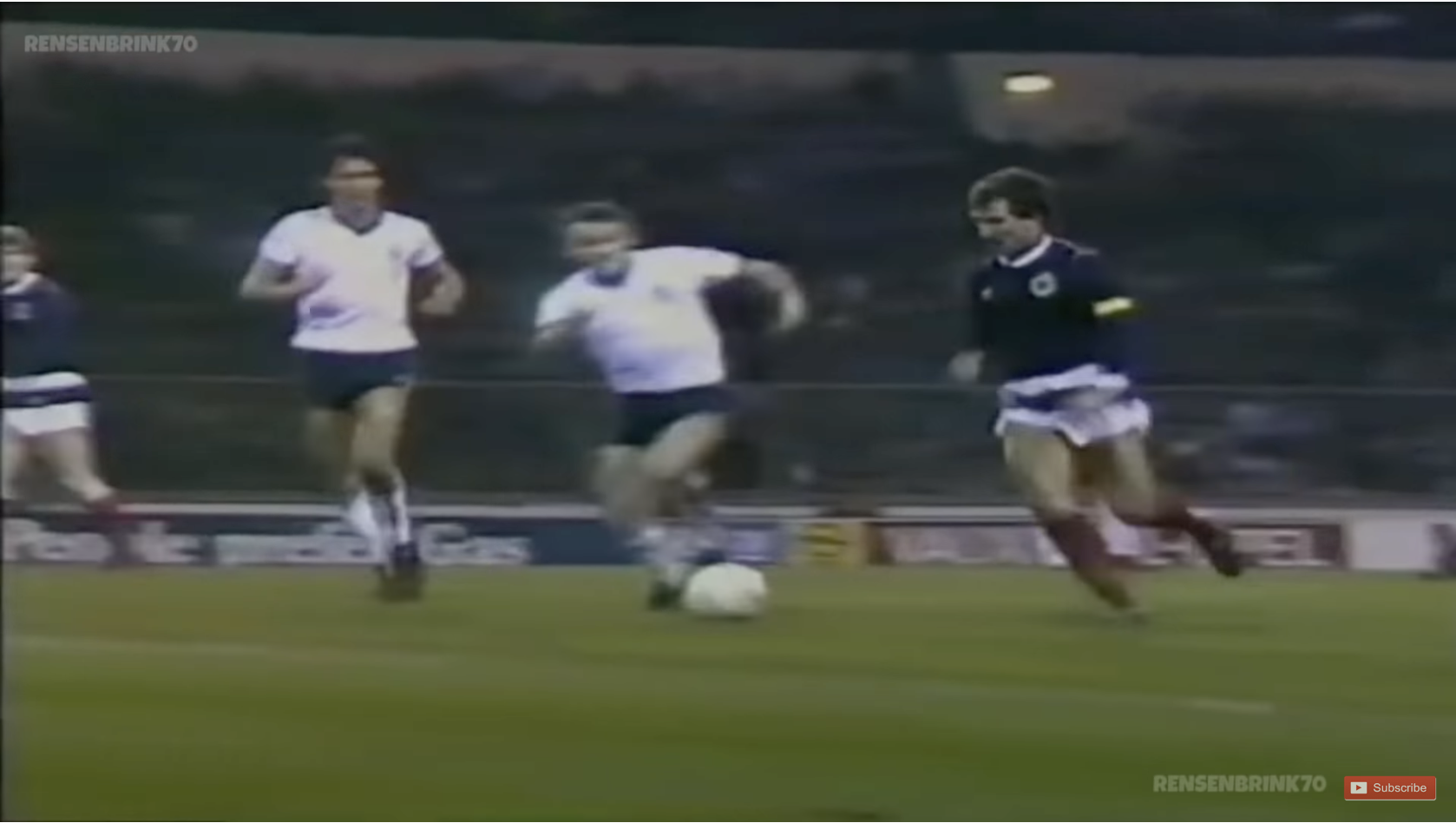These weeks, the media is filled with the obvious humorous jibes at the adjective “spursy”. Recent results, (with “recent” being defined as the last 50 years), have facilitated the endless gag of Tottenham as eternals losers. Spursy as a brand has always been there of course, but it’s been the Italians of Chiellini and Conte who, in recent seasons, have extended it best.
It is de history
There is something Basil Fawlty-esque hilarious about the macaroni English being used to slam a club image like this. 🙂
“Pay de ticket”, with the hand gesture. Comedy gold.
However, what if there isn’t anything missing? Just the opposite: what if “the Tottingham” is actually cursed Giorgio?
The Boston Red Sox Curse of the Bambino refers to the decades long title drought of the team, that started with them selling Babe (The Bambino) Ruth to the hated Yankees.
Look away now, dear Spurs fans…
…The curse lasted nearly a century!
Spurs, in the early 70s, held the player registration to arguably the greatest midfielder Britain has ever produced. He signed as a 15 year-old apprentice under Bill Nicholson. In 1972, Graeme Souness was sold to Middlesbrough for £30,000.
Why would you do that? Nothing short of professional negligence, throwing away the chance to have had the dream midfield of Souness and Hoddle for maybe 10 years.
Who knows… but, maybe exactly, this is the Curse of “samthing always missing”?
I loved Graeme Souness, in a way only an obsessed teen football fan can. In a way, that no longer exists for me, a silly boyish passion belonging to a child of the past.
The Edinburgh man’s retirement this week from the Sky screens is today’s Sunday Column.
Click here or the image below to see the tribute video.
Total authentic box office.
Sport is about heroes who have influenced you, especially when you’re a lad. My colleague Giles Morgan provoked this with an excellent post on Crucible legend Dennis Taylor.
Souness is a marmite character, often badly maligned, indeed despised, by many of younger generations. Who was he to me?
I’d be lying if I said that I religiously followed his early career in the South. Let’s be honest, there were so so many great Scottish players travelling down the M1, straight out of school in those days. A veritable torrent of talent, and Middlesbrough wasn’t exactly a top team. Bobby Murdoch, though, was on Teesside at that time, and Murdoch was a historic figure in that iconic hooped shirt. So I got to know his young apprentice by association.
Bobby Murdoch, for the many who don’t know, was truly world-class, the midfield general of the great Celtic team of the 60s and 70s, and he took Souness under his wing.
You know what they say… the greats always recognise another of their ilk.
Jack Charlton was the man who took Murdoch to Ayresome Park: “I had him for four years and he was a great pro. He was one of those players who, if you crossed him by doing something nasty, could raise his game by five yards. Instead of being just a placid, good, knockabout footballer, he’d really put himself about just to show the other side. I used to say I hoped someone would kick him early in the game, because you always got a better performance out of him. Bobby was, without question, the best passer of a ball over distance I ever saw. If you got the ball to him he could play it back to you wherever you wanted – with pace to the near post, hanging at the back post or right across the face of the goal. “.
Murdoch’s prints are all over Souness.
Souness sucked it all up, and was grateful:
“Bobby came along and we all learned something from him. He was very much the guv’nor. Bobby had a European Cup medal with Celtic, as well as winning everything that could be won in Scotland. Everyone looked up to him, not just the Middlesbrough players, but all the lads who played against him. He still passed the ball better than anyone and he could look after himself on the pitch, too. Bobby wasn’t someone who pulled you aside and said: ‘You should be doing this’ or ‘you should be doing that’. Instead, he did it all by example. Bobby was an outstanding performer. I wouldn’t want to get into what he’d be worth today at his peak. But you couldn’t have got into that Celtic team unless you were a top player. And I think that says everything.”
Souness, in describing Murdoch, is ironically pretty much how we’d all describe Graeme now.
Life-changing encounters.
Every one of us always underestimates the impact of our chance meetings with people, who then will influence us profoundly.
By the mid 70s, Souness started getting a few caps. It was 1978, however, the step change, as he moved to Liverpool. Transfers back then, before Bosman freedom of contract, were much more rifleshot, much more “team building”. Players were brought in, very very specifically, to replace those being put out to pasture. The great Shankly Liverpool brought in Hansen for Smith, Dalglish for Keegan, and Souness for Ian Callaghan.
That’s what you call good business, I’d say.
1978 also saw Souness travel to Argentina with a Scotland team who massively underperformed (again). Souness wasn’t picked for the first two horrendous games. He instead was brought in for the last one against Holland. Scotland won that game and, in one of those excellent BBC tournament summaries, over the music of Evita, his image appear with the lyric “the answer was here all the time”.
That was me hooked on Souness. That little video summary.
Sport fandom does that. Unexplainable.
He was the leader of a Liverpool team, that then won three European Cups, five League titles and four League Cups. Astonishing.
And yet, he wasn’t especially loved in Scotland, where they considered him a bit of a fancy dan, a tall poppy. Archie Gemmill in fact called him a chocolate soldier. So full of it, that if he was chocolate, he’d eat himself.
So I felt myself a bit isolated and unpopular in being a fan of his, but he fitted the bill for me in what I liked. The Overmaths, the Antognonis of midfield. The straight-back head-high strutters.
Souness was significantly different from the archetypal Scottish midfielders of his era, like Archie, Hartford, Bremner, McGovern, Hay, forged in those 1960s pitches. Midfield then was trench warfare, where it was good to have quick feet, hustle, and a low centre of gravity. Souness, instead, was tall, swaggered, and looked like an actor. He could read and run a game, had a range of pass unsurpassed by his peers, scored his fair share of heavy goals, and he could also tackle. A ruthless dispenser of on-field discipline, if needed.
Souness was utterly compelling.
A mixture of Socrates and Dave McKay, with the ever-present menace of Vinnie Jones‘s psycho. Unique and so valuable. Had the lot.
What’s not to love in this video? Click here or the image to watch it.
Watching this clip, it annoys me so much when people superficially dismiss him as obsolete and dated. It’s nothing but a sign of ignorance.
This was a great, great player and captain. Indeed, the easiest way to judge a true value of a man is to observe by whom he is respected. Jock Stein, one of the greatest managers this island has ever produced, loved Souness. They were like chalk and cheese and should never have been the closest of friends – yet, they were.
Stein was once asked who was the best player he had worked with. “Oh, Bobby Murdoch,” Stein said without hesitation. (No surprises there!). “Mind you, Bobby couldn’t run. The best team player, by far, is Graeme Souness. There is seldom a moment when you play in central midfield, that you are not involved, but he still finds time to do things way above and beyond what’s required. He helps players in his own side without them even knowing. If somebody has a bad touch or makes a mistake, Graeme will be just a few yards away from him every time he gets the ball, so he can take an easy pass. And he’ll keep doing that, till the player has got his confidence back. I’ve never known anybody to do that. He’s the best team player you could wish for.”
This description is the man who comments on Harry Kane like this. Click the image to view. It all is consistent.
Look at Souness’s eyes, at how his Scottish accent comes back.
He is totally honest here. Inject that into my veins.
When told of Stein’s comment, Souness choked, eyes welled up and his voice softened: “I didn’t know he knew that… Oh, that is really something.” He paused, then added: “But I should have. His knowledge of the game was unbelievable. What a loss he is.”
Souness, the night Stein died after the Wales game, was utterly devastated. Wandering up and down the corridor in tears, all he could say was: “He’s gone…”
This, right here, is why Souness has little time for the Pogbas of this world. It wasn’t how he was brought up, or how he was taught to be a real player, and man, by Murdoch, Paisley and Stein.
As a result, it is so tragically wrong to project onto him some ideas of nasty and sinister prejudices. He is a very very kind and fair man, and a great leader. He is actually prone to raw emotions, and can’t hide them.
Read the man.
It’s also wrong to label him an insular dinosaur little Britisher. Souness would be the first to admit that he isn’t the most up to date on the latest coach in the Bundesliga experimenting with a counter press and inverted fullbacks. He won’t know well who De Zerbi is. That’s, however, not where he adds value as a pundit. All that data analysis side of football will all soon be done by AI, especially around recruiting and scouting. What the robot however won’t be able to do is “read the man“, and that is the differentiator that Souness brings to punditry. He knows the “not-worth-the-trouble” players a mile away. Players who will ruin your dressing room. Those who will let you down when it’s crunch time. For a broadcaster, it’s golden added-value insight, based on authentic opinions. Souness will be badly missed by Sky.
That same skill itself could be worth hundreds of millions in dodged bullets in today’s transfer market. A smart club would employ Souness to look at their short list of targets.
“Go and take in a few of his games, Graeme. Report back on his body language, his shoulder shrugging, his attitude when the team is struggling. Try and speak to him and who he hangs out with. Come back and tell us if he is one of us.”
Why football doesn’t do this is incomprehensible to me. Especially with a man of the world like Souness.
The Sampdoria years.
After an astonishing last game for Liverpool, beating Roma in Rome, he went to Sampdoria, to test himself again in another big league. He wanted to expand and grow as a man and a player, and he did exactly that in two excellent seasons, with more trophies. Go and ask in Genoa; they know. His relationship with Vialli is another testament to the real Graeme Souness. Huge heart.
It was around this time, that I personally met him when working on Sky’s Italian football coverage. He was a pundit, and I was a young hustling nobody stats guy, that he made sure he always acknowledged. The next time I’d meet him, he’d be Rangers manager on the club’s summer retreat in Barga, Italy. Again, a gent.
Souness’s legacy as Rangers manager.
He had taken on the role of Rangers player manager in the mid 80s and his impact was seismic. He brought a profile and respect to the game up there, signing the top top England players of the moment. Butcher, Wood, Stevens, Wilkins et al. But that is not his true legacy. Rangers are a fiercely protestant club which, shall we say, never used to find Catholics to sign. In today’s inclusive world, that kind of apartheid is unthinkable. However, in 1988, it was that club’s entire raison d’être. It was their brand, maybe still is. Souness ended that overnight, by signing ex celt Mo Johnson, on a day that is perhaps the most dramatic in all of the history of Scottish football. Souness, knowing in advance of the feral fan protests, the ceremonial burning of Ibrox season tickets, could have chosen not to have fought that battle. That’s death threat dangerous up there, and he had a young family. But he did it anyway. Some say it was because his wife was a catholic. Others laugh that, with one stroke, he flattened the Celtic spirit for a decade. He just was brave enough to do the right thing. As a Glaswegian, as a Celt, thank you Graeme.
The move to Liverpool.
Liverpool, his first love, called on him four years later to be their manager. He couldn’t resist, although it was clear to many that it was a mistake, as the Anfield Dynasty was ending. The Souness attempts at the change that was sorely needed rubbed up a lot of old timers at the club, mainly Phil Thompson and Tommy Smith. Souness himself was starting to show increasing intolerance in his man management in general. He was also not a well man, showing that the heart disease in his family was indeed hereditary. He, of course, didn’t help himself, with a very ill-advised exclusive with The Sun newspaper, a publication despised in the city for their Hillsborough coverage. An episode, which Souness calls the greatest error of his entire life. He left Anfield for Turkey, pretty much in failure.
The interlude in Turkey.
He went to manage Galatasaray in June 1995, an unremarkable career interlude made famous really only for causing a riot, after placing a large Galatasaray flag into the centre circle of the pitch of arch rivals Fenerbahçe. The iconic image of Souness planting the flag, drew comparisons with Turkish hero Ulubatlı Hasan, who was killed as he planted the Ottoman flag at the end of the Siege of Constantinople. Once more, an emotional man, with a low boiling point for his blood, doing something not recommended for the faint-hearted (which, of course, he medically was). Not many, though, have that Turkey experience in their list of dinner-party anecdotes.
And the last, unconvincing assignments.
He moves to other managerial jobs at Southampton, Torino, Benfica, Blackburn, Newcastle, without ever succeeding the way he would have wanted. This is where his critics of today may have some mileage. As Souness admits, he found it more and more difficult to bite his tongue in the changing power dynamics of players and dressing rooms. Graeme Souness has a short fuse and doesn’t suffer fools. That doesn’t work with today’s player power and, I’d argue, his personality is too pure and authentic to fake empathy.
His Liverpool team-mate Michael Robinson said of Souness in 2016: “I found him a very personal, cuddly chap who was actually quite vulnerable about being a human being with emotions. To this day, he still tries very hard not to be this lovely cuddly person, when really he is.“
Anyone who doesn’t see the value in Graeme Souness has, in my opinion, a real issue themselves.
He for sure isn’t perfect. But he is true, and genuine. And a good man. I don’t need to add that he was a great great player and captain.

Listen to our “Are you not entertained?” sports management podcast here.
Let us also recommend our wonderful colleague John WallStreet. His daily newsletter here is essential reading, especially in its coverage of the US market.
To find out what we do in change management, have a look here.
For our C-suite management services, read here.
Here you can know more about our content development work.
Discover our Corporate Learning service.
Get to know more our “Sport Summit Como” yearly sports management event here.
If you are interested in our own story, check us out here.






